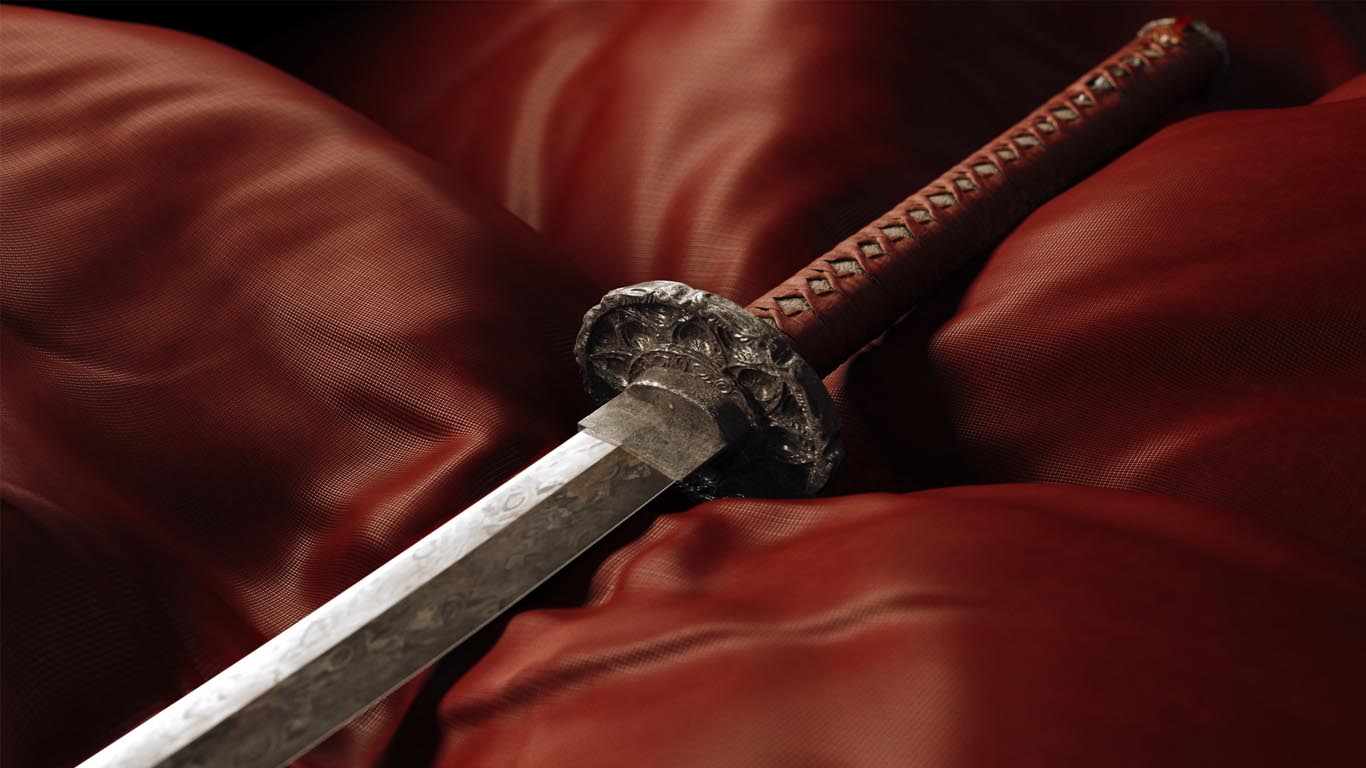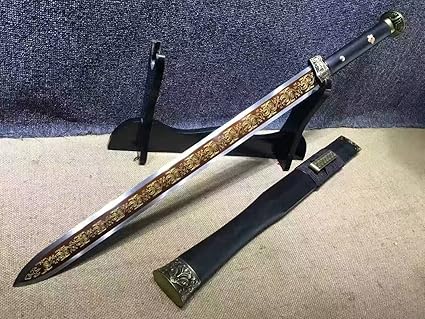Black Blade Katanas: Mythology. Being of tenebrous color, the black blade Katana is considered as an amazing feature you can add to your sword, making it dark and mysterious. The black blade Katana is considered in mythology as an enchanted tool that the carrier is whether an assassin or a hero. Most claim it to be made of material coming from outside Earth like a meteor, and usualy considered.
NOTE: There are a few exceptions to this rule. Stainless steel swordscan be used for NON CONTACT forms practice. And there have been a fewsmiths who have been able to use more sophisticated techniques to makeit suitable for cutting - but these techniques come at a price, and arenever found on the 'surgical grade 440 stainless steel' blades beingsold on the Internet and marketed as battle ready because they aresharp. (High) Carbon SteelAt the very least, for a functional sword it has to be a (properlytempered) 'High Carbon steel sword'.
But what exactly does this mean?Generally, The American society of automotive engineers (SAE) scale isthe one most commonly used by sword manufacturers. Be especially wary of unknown sword brands or vendors on eBay claiming exotic steels at low prices. More often than not, they are using 1045 carbon steel and hoping that you won't notice the difference.1045 Carbon Steel swords are quite cheap to make because, beingrelatively soft, they are easy to make (either by hand forging, pressingor machine milling). Because the minimum carbon content starts at 0.40%- and 1045 carbon steel is 0.45% - it is effectively the MINIMUMacceptable steel for a functional blade.If properly tempered and hardened however, 1045 carbon steel swords can be surprisingly strong, and when you look at asword under or around US$100, if it just says 'high carbon steel' - it isprobably 1045.
Cross-section of a Folded Steel BladeYes, you can get quiet functional ones - but they tend to be in the $800 plus price range. One of the better ones is made by the Imperial Forge and - the review is insightful and shows the limits of what a folded steel sword can handle as well as discusses common folded sword steel myths and misnomers.And even then they are still not quite as durable as a simple unfolded blade made from pure modern steel. (but they look nicer - and are more traditional, so it just depends on what you like and your intended usage). Other, less common sword steelsWhile the sword steels listed above cover the vast majority of steels used for making modern functional swords, there are many others used less frequently.One of the best guides to these lesser known and less common sword steels can be found - with short, but to the point listings of over 30 different steel types.hope this information on Sword Steels has been helpful.
JAPANESE SWORD IDENTIFICATION - Is it old? Is it real?THE JAPANESE SWORDIS IT REAL? - IS IT OLD?A General Guide For The Non-CollectorNOTE: The following suggestions for determining whether a Japanese sword is old or new (WW II era or later) are only general guides. No single indicator alone will determine whether a sword blade is anantique or of recent vintage.
The blade must be examined in its entirety and not judged solelyon a single criteria. Do not undertake to dis-assemble a sword unless you know what you aredoing. You may severely injure yourself and/or damage the sword. For definitions of terms, check the page.The first question to be answered - is it a real sword or a modern replica or aniaito (iai practice sword)?

Black Rust On Eteched Sword Of Fire
Many modern replicas and iaito have aluminum blades. When in doubt, check the blade with a magnet. Steel is magnetic - aluminum is not. If the blade is aluminum, the sword is nota 'real' sword and certainly not an antique.
However, just because the blade is steel does not mean it is a genuine Japanese sword as many modern replicas are made with steel blades. There are also numerous reproduction and fake Japanese swords onthe market.
Also many Chinese military swords are confused with Japanese swords. Be sure to read.' Ninja swords' are a Hollywood fiction. There is no historical documentation that ninja used swords which were of a special design or differed from those used by other Japanese of the period.
Any so called 'ninja sword' is pure fantasy.Is there visible grain (hada) in the steel of the blade? Most handmadeJapanese swords will have a visible grain in the steel of the blade. This is due to the methodof forging the blade using multiple folds,etc. Grain (hada) is sometimes difficult for beginners to recognize.There are old sword blades which have no visible grain (muji hada); however, the presence of grain doesmost certainly mean the blade is handmade.
Grain does not determine age. Many of the betterWW II era swords will show prominent grain (hada). Does the blade show a true temper line (hamon)?
How To Fix A Sword

Replica swords and manyWW II era machine made swords have an etched temper line, not a true temper line (hamon) madeby differential tempering of the blade. Examine the hamon with a magnifying glass. A real hamonwill show tiny dots/specks (nioi and/or nie) along and between the border of the hamon and the rest of the blade.
An etched temper line will be seen as a smooth cloud lacking any internal features.If there are serial numbers stamped in the blade, it is a machine madeblade - most likely a WW II NCO sword. These are all machine made and are not classified as 'Nihonto'.Check the for examples of WW II eraswords.Is the blade sharpened all the way to the base where it joins the hilt?Most WW II era blades are not sharpened all the down to the habaki (collar). Some older (Shinshinto)swords may likewise not be sharpened down to the habaki; however, most WW II swords were not.If the blade is not sharp all the way to the habaki does not assure it is a WW II era blade, but isa good first indicator.If the peg (mekugi) or screw holding the handle (tsuka) onto the blade can be removed and the handle safely removed (use care not to damage the handle or blade - the complete handle should slide off the end of the tang), examination of the tang (nakago) can tell much about the age of the blade. (NOTE: Some swords may have two mekugi - one near the guard and the other near the end of the hilt. Always check.
Never use force to remove the handle.) Newer swords will have a grey, metallic tang perhaps with a little red rust. (Do not remove the rust). Older swords will have more rusted tangs, ranging from brown to smooth deep black rust for the oldest swords.
On newer swords the file marks on the tang will be sharp and crisp. As the tang rusts and ages, these become progressively smoother and less distinct.NEVER CLEAN THE TANG OF A JAPANESE SWORD OR TAMPER WITH IT IN ANY WAY!!! - it will reduce its value by at least 50 percent!! The type and color of the rust is used to help date and to authenticate the blade.Is the tang (nakago) signed? Many people tend to believe that if a swordis signed, that it must be hand made. That is not true.
During the WW II era, many machine made bladeswere signed simply as a way of giving more prestige to the sword even though it was machine made.The reverse is also not true - if a sword is not signed does not mean it is machine made. Many, manyantique blades were left unsigned or have had their signatures (mei) lost over time. Whether a blade issigned or not has little to do with determining if it is handmade or the age of the blade.If there is a tang stamp (see the for examples) on the nakago, up close to the blade collar (habaki), it is a WW II era sword - these are arsenal stamps. Arsenal stamps do not appear on pre-1930's blades.There are stories that the small papers between the handle wrap (ito) andthe rayskin (same') are prayer papers to protect the soldier in battle.
This is pure fiction. These are simply paper spacers to aid in positioning the wrapping properly on the handle. DO NOT UNWRAP THE HANDLE!
The process of tsuka-maki (handle wrapping) is quite complicated. You cannot re-wrap the hilt with the silk cord that was removed. It will have shrunk and is likely frayed and worn. Consult someone who is trained in tsuka-maki if you need to have a handle re-built.Sword canes (Shikomi-zue) mostly have very low grade blades. Most sword canes were produced in the late 19th Century - early 20th Century.
Black Rust On Eteched Sword Of Arms
The blades are very straight and thin and often have significant flaws. The scabbards and hilts are usually designed to resemble bambooor old wood sticks. Rarely is a high quality blade found in sword cane mounts; however, some ofthe mounts can be interesting with hidden, spring loaded, pop out guards.How the sword is mounted has nothing to do with its age or authenticity.Modern replicas may look like antique swords; be it a tachi, katana, wakizashi or tanto. WW IImilitary type swords are also being reproduced today. WW II era swords have been put into shirasaya orremounted in samurai type mounts by collectors. Vice versa, antique blades are occassionally foundin WW II military mounts.There are numerous varieties of items made in the 20th Century astourist momentos that are commonly thought to be some special type of Japanese sword.These take that shape of various dragon figures, Japanese peasants, fish etc.
all carved andpainted wood figures. The blades in these items are all 'soft steel' and have etched temperlines(hamon). Many will have some type of engraving, usually floral, on the blade. These items are ofno interest to Japanese sword collectors. Bone tanto and swords (see below) fall into this group.Carved bone and carved ivory sword mountings almost always have untempered, soft steel blades.
These were made as tourist items from the 1870's through the 1930's. These items are purchased for the quality of the carving only. The great majority of these swords are made of carved bone, not ivory. Ivory has a distinctive grain. If you cannot see this grain or do not know what to look for, assume it is carved bone, not ivory.Swords with carved bone handles and scabbards areof no interest to Nihonto collectors other than perhaps as an example of how poorly made a bladecan be. They are referred to as 'hocho tetsu' (kitchen steel) - a most derogatory term in sword circles.
Swords of this type were made in all sizes, from tanto to katana or tachi. Some of these bone swords will have very low grade metal mountings, commonly with the Tokugawa mon incised into or embossed on the mountings.The above items are only a general guide. When ANY doubt exists as to the authenticity orage of a Japanese sword, seek advice from a reputable collector. There are numerousin many cities. Contact one of them for assistance.If you are lucky enough to be in the possession of an authentic Japanese sword,whether it is of WW II vintage or an antique,be sure to properly.
